Excerpts from Jim Conrad's
Naturalist Newsletter
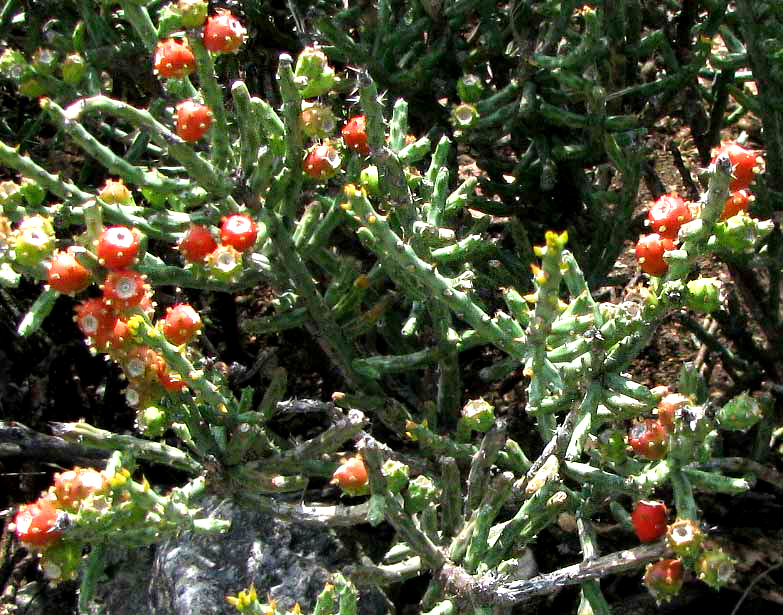
from the October 6, 2013 Newsletter issued from the Frio Canyon Nature Education Center in the valley of the Dry Frio River in northern Uvalde County, southwestern Texas, on the southern border of the Edwards Plateau; elevation ~1750m (~5750 ft); N29.62°, W99.86°; USA
TASAJILLO CACTUS
As with the Leatherstem, farther west in and around the Chihuahuan Desert, one of the most abundant and easy-to-identify cacti is a slender-stemmed, bushy one that usually grows knee to waist high, and nowadays bears large number of red, mothball-size fruits. A small section of one forming a bathtub-size tangle atop a hill a few miles south of Juniper House is shown above. A shot giving a better idea of the cylindrical stems' size appears below:
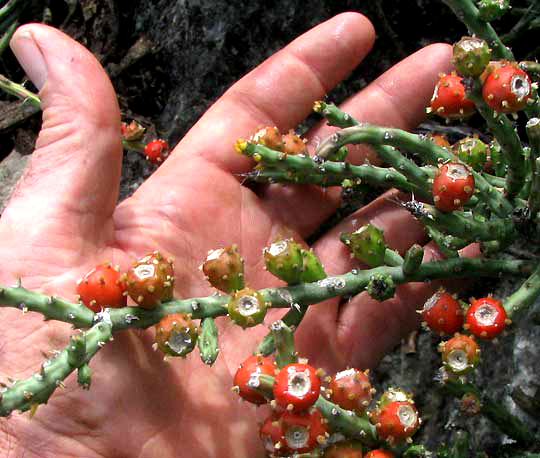
Note that this species bears no large spines. However, the close-up of fruits below shows that the cactus can produce dense clusters of tiny, very slender and sharp spines called glochids, which easily stick into your skin with the merest of touches:
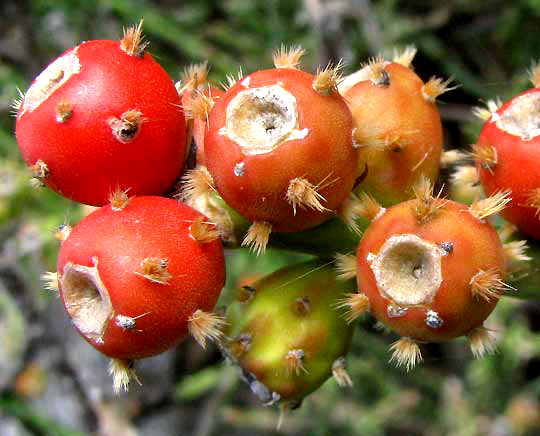
This is CYLINDROPUNTIA LEPTOCAULIS, variously called Tasajillo, Christmas Cactus, Desert Christmas Cactus, Christmas Cholla and Pencil Cactus. Probably most books list it as Christmas Cactus, but another species with flat stems is much sold under that name during the holidays.
Tasajillo occupies a wide variety of arid habitats throughout most of the northern half of Mexico, and extends in the US from southern California to southwestern Oklahoma and eastern Texas.
Several sources describe Tasajillo fruits as edible, including one webpage saying that indigenous Americans made jam from them. However, the berry-type fruits are so small and bear so many finger-sticking glochids that it's hard to imagine anyone eating many. My Mexican friends showed me how to beat cactus fruits with soft-leafed weeds to remove glochids, so maybe if you can develop a technique like that it might work.
One important service contributed by Tasajillo is that its interconnecting branches can form impenetrable tangles providing refuge and nesting sites for small animals such Cactus Wrens. And somehow deer, quail, wild turkey and many other small critters feast on the berries, glochids or no.
Nowadays as cities in arid areas try to convince people to abandon grassy lawns, Tasajillo is becoming an important candidate for xeriscaping, especially because with its green stems and red fruits it stands out so prettily amidst otherwise bleak winter vegetation.
from the February 23, 2007 Newsletter issued from Sierra Gorda Biosphere Reserve, QUERÉTARO, MÉXICO
ATTACKED BY A CHRISTMAS CACTUS
Wandering through the scrub, an odd sensation on the back of my right leg caught my attention. It was as if suddenly I'd developed some flab there and my walking was causing the flab to flop back and forth. I twisted around and looked down at the back of my leg and saw the heart-palpitating sight you can behold yourself below:
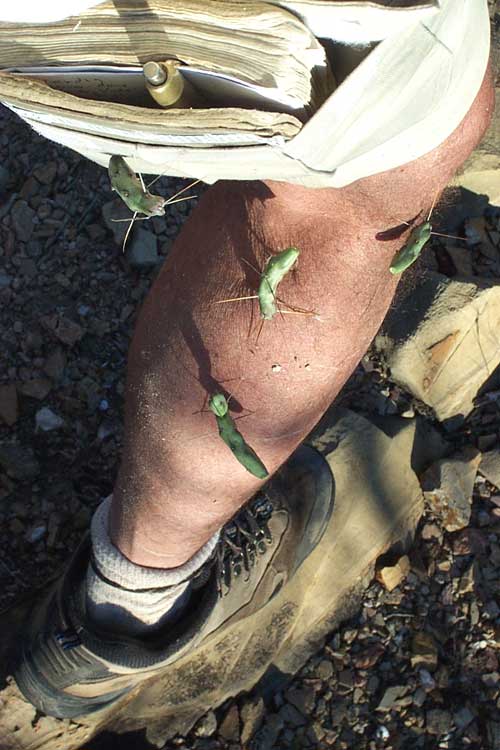
That picture shows four stem sections of a Christmas Cactus, CYLINDROPUNTIA LEPTOCAULIS, adhering to my body by their spines, one stuck to the shorts' pocket in which I carry my old birding field-guide, the other three very securely attached to the skin on the back of my leg. I can't account for my having been able to feel the cactus sections swinging back and forth, but not the spines stuck into my flesh. Well, you can see from my red, scratched and dirty legs that they'd been through a bit scrambling about the arroyos, so maybe they were just beyond feeling sharp sensations. However, when I extracted the spines -- and each section was attached by two or more well anchored ones -- I certainly felt that!
I backtracked and photographed what may have been my five-ft-tall, much branched donor cactus, and you can see that below:
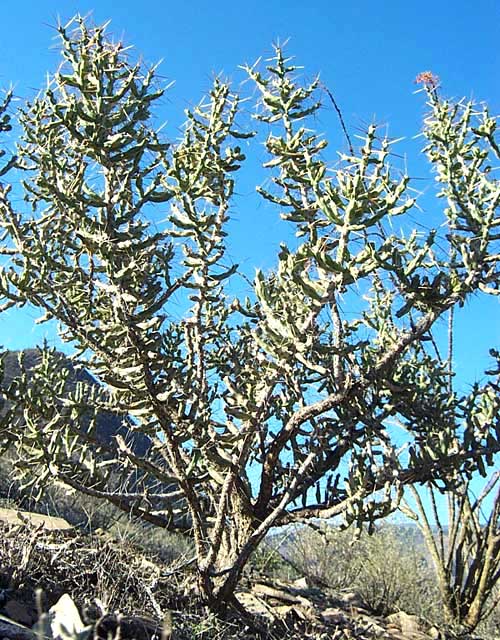
I can hear some folks shaking their heads now saying that what's shown in that picture doesn't look anything like a Christmas Cactus, thinking that a Christmas Cactus is one of those benign little flat-stemmed cacti sold in pots, and which produce pretty, red flowers around Christmas time. Well, several cacti go by the name of Christmas Cactus and this is one of them. But neither does the plant in my picture look very Christmassy. I've seen the species when it did, however -- when it was fruiting. The fruits are bright red, so on green stems they can look as Christmassy as anything. Sometimes English speakers also call this cactus by one of its Spanish names, Tasajillo.
This is a common cactus extending from our northern Mexican uplands into Arizona, New Mexico, Texas and even Oklahoma. At the base of its spines appear dense tufts of very fine, sharp glochids, which I've told you enough about, and I got plenty of those while unsticking myself from the joints on the back of my leg.